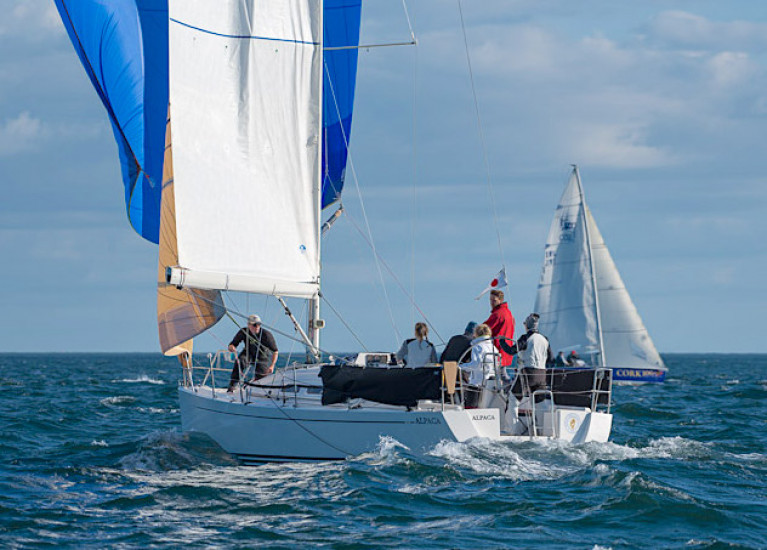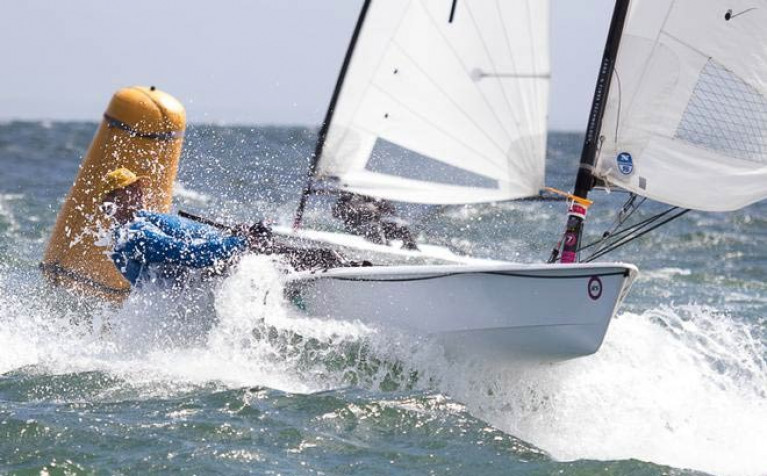Displaying items by tag: Corona Virus
What Covid-19 Means for Irish Sailing Fixtures in 2021
It's March 1st and depending on who you talk to there is either tremendous optimism that the 2021 Irish summer sailing season can get underway as scheduled or alternatively, the ongoing pandemic will force us to navigate a stop-start season like we did last year.
Certainly, with an estimated 82% of the population vaccinated by the sixth month of 2021, the hope is it could be full steam ahead. Some pundits say such a timeframe will, unfortunately, be just too late for some early fixtures that are now 'fifty-fifty'. Others predict the season will get away alright but not until June.
Despite the unpredictability of the challenges, ICRA Commodore Richard Colwell told Afloat this weekend, he is hopeful that the season ahead will be a good one even if there might be difficulties early on.
Other regatta organisers say they are much more confident of regattas going ahead than they were even two or three weeks ago, such is the changing scenario but there is no doubt confusing messages and lack of clarity is raising the ire of a weary nation.
The Government’s revised plan published earlier in the week focuses on the phased return of schools and childcare. There is little change to the published five levels of the ‘Living with Covid Plan’. You can read the full Government update here
Ireland remains under current Level 5 restrictions until 5th April at the earliest when Government has stated that the “staggered start of easing of other areas of restriction with a focus on outdoor activities including sport” may be considered.
 Organisers of big yacht racing events have made plans to be COVID compliant, including Volvo Dun Laoghaire Regatta that will be split over two weekends in July Photo: Afloat
Organisers of big yacht racing events have made plans to be COVID compliant, including Volvo Dun Laoghaire Regatta that will be split over two weekends in July Photo: Afloat
Mary O'Connor, CEO of the Federation of Irish Sport, has called on the government to produce "a detailed roadmap" on the reopening of sports so that their 81 national governing bodies can make plans for a return "in a safe manner". In sailing's case that would certainly make a lot of sense both for volunteer organisers and competitors alike.
Clubs planning major regattas – often a year or more in the making – are again faced with impossible decisions.
Already, May's Scottish Series on the Clyde has been reformatted in a bid to cope with restrictions. Irish boats face quarantine requirements if they travel.
 ISORA’s new early-season cruiser-racer fixture along the Dublin coast was cancelled in January's lockdown restrictions Photo: Afloat
ISORA’s new early-season cruiser-racer fixture along the Dublin coast was cancelled in January's lockdown restrictions Photo: Afloat
A new ISORA 'Early Season Series' originally planned for January was to continue the offshore's body's successful 2020 coastal racing out of Dun Laoghaire Harbour. However, the current lockdown put paid to those plans, leaving ISORA boss Peter Ryan to reschedule for later in 2021.
The 2021 Irish Youth Sailing National Championships planned for April has moved out to October at Royal Cork Yacht Club.
June's Bangor Town Regatta has been scrubbed entirely on Belfast Lough.
Buds of the new season are, nevertheless starting to appear. This weekend and last weekend's warm westerlies on Dublin Bay, the country's biggest boating centre, showed plenty of activity out from Dun Laoghaire Harbour. Solo sailing or sailing in pods is proving popular with RS Aeros, four Fireballs, two foiling Waszps, a GP14 as well as a number of sailing cruisers all enjoying some recreational sailing and boating.
The National Yacht Club lift-in of sailing cruisers and keelboats is currently going ahead on April 9th and so is the Royal St. George on April 10th, both key signs of a determination to get 2021 underway.
In the latest Commodore’s Update from Howth Yacht Club, Paddy Judge has outlined its plans for a hopeful restart to sailing if restrictions allow from April.
 2020 DBSC Turkey Shoot and 2021 Spring Chicken Series racing fell to Covid-19 on Dublin Bay Photo: Afloat
2020 DBSC Turkey Shoot and 2021 Spring Chicken Series racing fell to Covid-19 on Dublin Bay Photo: Afloat
Dublin Bay Sailing Club, the umbrella organisation that runs racing for all four waterfront clubs in a combined fleet of 250 sailing cruisers and dinghies and 1,200 members, is scheduled to start on Saturday, April 24th. New Commodore Ann Kirwan has the unenviable job of trying to prepare for a season that includes the significant cost of laying over 20 marks across the bay and preparing for a first race while at the same time trying to keep an eye on transitions between Government COVID levels, where there will be ‘amendments’ published, based on the most recent medical advice at the time.
 Dun Laoghaire Laser sailors racing inside the town's harbour in 2020. It looks like the single-handed DBSC class will get a further boost this summer thanks to the continuing threat of COVID-19 Photo: Afloat
Dun Laoghaire Laser sailors racing inside the town's harbour in 2020. It looks like the single-handed DBSC class will get a further boost this summer thanks to the continuing threat of COVID-19 Photo: Afloat
The question is will Ireland possibly go from Level 5 to Level 2 from April 5th to April 24th, a scenario that would allow the first DBSC race of 2021 get underway on schedule?
Either way, it will be another altered season with hospitality and clubhouses not scheduled to open till mid-June. Certainly, the Government Advisory in operation against all non-essential international travel will impact events such as Dun Laoghaire's staging of the Laser 4.7 World Championships planned for August.
DBSC was a bellwether in 2020, achieving a remarkably full programme in 2020 when Pandemic Regulations permitted, a feat that led to the club picking up the Mitsubishi Motors Sailing Club of the Year Award.
Certainly, if DBSC gets underway it will provide great hope to other race and regatta organisers such as June's Volvo Dun Laoghaire to Dingle Race, O'Leary Insurance's Sovereign's Cup in Kinsale and July's Volvo Dun Laoghaire Regatta, where they have already put in place pandemic restriction measures to reduce numbers.
Increasingly though it looks like international travel restrictions will kerb UK visitors to the 2021 Irish regatta circuit.
 Keith Miller’s Yamaha 36 Andante from Kilmore Quay is one fo ten Irish yachts registered for August’s Fastnet Race where COVID protocols are likely Photo: Afloat
Keith Miller’s Yamaha 36 Andante from Kilmore Quay is one fo ten Irish yachts registered for August’s Fastnet Race where COVID protocols are likely Photo: Afloat
In the UK, RORC has announced it expects to return to overnight offshore racing and the London club is planning a return to its Spring Series on the Solent in April.
But for now, even for events as late as West Cork Calves Week in August or the ICRA Nationals in September, the advice of Afloat's WM Nixon given last December still rings true; Irish Sailing Fixtures for 2021? The Best Plan is to Keep Planning.
There will be updates from regattas organisers at next weekend's ICRA conference. More here.
If you have any observations or queries, please email Afloat and we will do our best to clarify any of the Government’s guidelines.
Ireland's Coronavirus Cancellations? Healthy Club Sailors Have Had To Accept It With Good Grace
"I just want to go sailing and racing. Until we had to slam down the shutters this week, I didn't really realise just how much the ordinary club sailing programme and a special local annual series like the Autumn League means to me and people like me, and to sailing families throughout Ireland."
"I don't think those who advocate such across-the-board moves realise what a damaging effect stopping us going racing has on the physical and mental well-being of Ireland's grass-roots sailors. We never needed our sailing more than we do now."
The speaker is lifetime sailor Darragh Connolly, Rear Admiral (Keelboats) of the Royal Cork Yacht Club, and we were talking a couple of days after he'd had to announce that the remaining races of the Club's popular AIB Autumn League had been cancelled in compliance with Irish Sailing's directive, in light of our National Authority's interpretation of the Government's imposition of Level 3 in the COVID-19 Combat Programme.
 Darragh Connolly, Rear Admiral (Keelboats) of the Royal Cork Yacht Club, this week had the unenviable task of calling an early close to the RCYC AIB Autumn League. Photo: Robert Bateman
Darragh Connolly, Rear Admiral (Keelboats) of the Royal Cork Yacht Club, this week had the unenviable task of calling an early close to the RCYC AIB Autumn League. Photo: Robert Bateman
It is clearly arguable that the Government Directive, as interpreted by Irish Sailing, is actually preventing people from doing something which is beneficial to their overall physical and mental health, an activity which in turn is very positive in enhancing their ability to reinforce their natural resistance to contracting COVID-19.
And for Ireland's many club sailors, it is particularly bewildering to have arrived at this situation in this week of all weeks, when Irish Sailing will have played the key role in having our Laser Performance Group and other top potential Olympians taking part (with laudable success) in major events in places like Poland and Austria, countries which - like Ireland - are currently coping with a rising coronavirus rate.
 Who's for racing? The busy start line in this week's Laser Senior Europeans in Gdansk
Who's for racing? The busy start line in this week's Laser Senior Europeans in Gdansk
The infection risk which our athletes are taking in travelling across Europe, and then competing in an event which will have numerous supporting officials, is surely significantly greater than a local club sailor has in joining her or his boat in its familiar berth for another two or three hours of healthy racing in a successfully-proven socially-distanced setup.
KNIFE-EDGE DECISION?
There are those of wide experience in sailing administration who reckon that it was actually a knife-edge choice as to whether or not Level 3 means that local sailing races were now off-limits. But being a minority sport like sailing, with a possibly problematic image of affluence and elitism, when the directives come down from above our national officialdom has to toe the official line, keeping the head down to go along with the mantra that we're all in this together.
Inevitably in such a situation, the simple hopes of the grassroots get trampled under foot. Yet if we stand back and take a cold hard look at the situation, the variations in the situation between those who would be actively racing in boats afloat if they could, and those who are most at risk ashore, is an enormous chasm. Applying a "one size fits all" approach to the crisis situation may help in terms of a benign public perception of different sports and activities and shared risk, but it flies in the face of reality. And in terms of the well-being of this clearly identifiable sector of the population who want to go sailing, it's actively harmful.
 "Once upon a time in West Cork". In order to keep their sport going, the Irish sailing community have had to become accustomed to doing entirely without carefree assemblies like this one in Baltimore.
"Once upon a time in West Cork". In order to keep their sport going, the Irish sailing community have had to become accustomed to doing entirely without carefree assemblies like this one in Baltimore.
Put crudely, "We're all in this together" is a denial of the facts of the situation. Certainly, we're in the same storm, but we're in some very different boats. The incidence of coronavirus among those who would be regularly sailing actively - if they were allowed - appears to be vanishingly small.
We've been taking an admittedly random sample from a small population, but we know of only two sailors who came down with the bug (and both have recovered). One case is a fearless bow-man (of course) who was right in the thick of it in January on a hectic ski-ing holiday to Coronavirus Central – otherwise Ischgl in Austria - while the other got it on a group golf outing to Spain.
COASTAL LIVING IS GOOD FOR YOU
Shoot us down in flames by all means if you have knowledge of significant occurrences of COVID-19 in the sailing population as a result of being sailing. But the fact is that everything in our sport militates against it. For a start, though you can sail almost anywhere in Ireland, the majority of the sailing population lives in coastal districts. And the health benefits of this have been clearly demonstrated with brutal clarity in the Dublin area.
There, the lowest occurrence is in Blackrock in its breezy ozone-filled location on the shores of Dublin Bay, where the level of infection is only a fraction of the levels away up in the crowded northwest of the city, where it's about as far from the sea as you can get within city limits.
 "Healthsville, Ireland" – the seaside township of Blackrock has the lowest incidence of coronavirus in Dublin.
"Healthsville, Ireland" – the seaside township of Blackrock has the lowest incidence of coronavirus in Dublin.
Admittedly that's a rather vague and generalising analysis, but this week, much more specific figured were published comparing coronavirus incidence in coastal towns with that of inland towns in England and Wales. As many of the coastal towns have a notably older population than the inland centres, you'd expect a disease-favouring bias in the seaside retirement region. But even with that, the difference in the opposite direction is very marked.
STAY ALIVE – STAY BY THE SEA
It's complex to make a full analysis, as the older demographic of most English coastal towns may mean less active socialising, and a greater readiness to cocoon completely. But nevertheless, the figures are quite stark - at this stage of the Pandemic, the COVID-19 death rate in England's large coastal towns is 63 per 100,000, while in inland towns of comparable size, the death rate is 102 per 100,000.
Of course, you can get some benefit from coastal living simply by throwing open the window from time to time (mock not, it is extremely important to do so), and getting outside and absorbing as much Vitamin D as possible in that ozone-laden air, for enclosed spaces are the virus's accomplice, and Vitamin D deficiency - a significant problem in Ireland – is offering Mr COVID-19 a welcoming open door.
You can meet some of the health requirements by taking a solitary or socially-distanced walk down Dun Laoghaire pier. But if you really want to find the optimal conditions for building up resistance to coronavirus, you'll find them as a member of the crew pod aboard a sailing boat racing in an Irish club event.
 Better than a spa treatment. While a walk down one of Dun Laoghaire's pier has enormous health benefits, even better for overall physical and mental health is having a busy Water Wag race in the harbour. Photo: W M Nixon
Better than a spa treatment. While a walk down one of Dun Laoghaire's pier has enormous health benefits, even better for overall physical and mental health is having a busy Water Wag race in the harbour. Photo: W M Nixon
There's social stimulation, mental alertness, thinking and problem-solving of a kind totally different to what's required ashore, and there's exercise, team effort, very fresh air, and the effortless absorption of Vit D.
NO SPECTATOR CROWD PROBLEMS
And we're not a spectator sport. Nobody would pay to watch ordinary sailing, for the only worthwhile way to do so is by actively taking part. Thus sailing does not have crowds of undisciplined supporters and spectators who flout every social-distancing rule and mask-wearing requirements with total abandon when their team has won. In sailing by contrast, while clubs have been taking heroic steps to provide outdoor catering and space to maintain social distance, the reality is that many sailors have simply tidied up their boats at race's end, and gone straight home, having long since become accustomed to doing without the traditional après sailing.
Now all this is denied to us, even with the compliance with all rules, and the extremely low – if at all – incidence of coronavirus in the sailing population. In this situation, sailing administrators have been between a rock and a hard place in the face of the one-size-fits-all restrictions being imposed in pursuit of COVID-19 clamp-down.
BOATS SIT UNUSED, GOOD SAILING DAYS GO TO WASTE
The grass-roots sailors want to go sailing and particularly club racing. They know it is good for them. They can see elite international athletes getting in their sailing. They can see people who are learning to sail being allowed to go sailing. Yet in the face of this very blunt instrument, a blanket ban which covers activities of many very different kinds, boats sit unused. Good sailing days go to waste. Sailors go to seed. And our clubs, our remarkable clubs that are Ireland's greatest contribution to the development of sailing worldwide as we know it today, are facing a crisis situation.
 You're not only having fun – it's actually very good for you. Paul Reilly and Dave Howard sucking up the Vitamin D and all the right kinds of ions as they race one of Howth YC's J/80s in the annual Aqua Restaurant Two-Handed Race in July. 2020's staging had an entry of 38 boats, the winners were Diane Kissane and Graham Curran in another J/80, and in a compressed season the memories of this special event – which was raced round Lambay – will become ever more precious. Photo: Lynne Reilly
You're not only having fun – it's actually very good for you. Paul Reilly and Dave Howard sucking up the Vitamin D and all the right kinds of ions as they race one of Howth YC's J/80s in the annual Aqua Restaurant Two-Handed Race in July. 2020's staging had an entry of 38 boats, the winners were Diane Kissane and Graham Curran in another J/80, and in a compressed season the memories of this special event – which was raced round Lambay – will become ever more precious. Photo: Lynne Reilly
In the seeming dead-end of this rock-and-hard-place situation, the good news is that Ireland's club administrators – the real backbone of our national sailing infrastructure – have been closely conferring of late to see if they can come up with a more imaginative and visionary way of dealing with the situation in order to get people sailing within sensible limits which takes account of the fact that in face of the virus incidence continuing to rise, the relative death rate continues to fall, or it does as long as supplies of the new medications continue to meet demand.
If all this seems a slightly selfish approach by a relatively fortunate sector of the population, nothing could be further from the truth. If the sailing community thought for a moment that totally giving up sailing would make a real difference to the spread of COVID-19, then they'd stop it today.
But instead, one of those trying to get sailing going again says that much of his motivation has come from meeting people in the front line of the battle against coronavirus who also happen to be keen sailors. He says their shared opinion is that being able to go sailing and get in a spot of racing even once a week is a real morale booster and a fabulous energiser after hours of working in ICU.
You would expect the sailing community to be more understanding than most others of the difficulties inherent in setting out any sort of comprehensible and feasible plan for the resumption of life in all its forms as the Covid-19 pandemic recedes, for our sport is an activity of many unpredictables. There may have been large pandemics before. But they didn’t occur in a significant form in such a complex and acceleratingly busy a world as we’ve been living in since the turn of the century.
Thus you can certainly make plans and keep making plans, but it would be foolish to expect anything resembling a Fixed Plan, all-encompassing and set in stone.
In sailing a race, for instance, the variables of wind strength and direction, sea state, tidal conditions, and configuration of the fleet are changing in an infinite and endless continuum. Rigid plans are a delusion. We may not all be like ace helm Gordon Maguire, who is so aware of the relative wind changes that he can anticipate them in advance by some time, and sense them in real terms something like a fifth of a second ahead of getting the information from the electronics, all of which can add up to quite an advantage in a complex race. But even the most basic sailor knows that everything turns out at least slightly different from expectation, and we go forth in the fond belief that it might even be better than hoped.
 Gordon Maguire (yellow jacket) helming Ichi Ban to Rolex Sydney-Hobart Race victory. It is his enhanced ability to anticipate and utilise the continuous change in the sailing environment which has made him Australia’s most successful offshore racing skipper
Gordon Maguire (yellow jacket) helming Ichi Ban to Rolex Sydney-Hobart Race victory. It is his enhanced ability to anticipate and utilise the continuous change in the sailing environment which has made him Australia’s most successful offshore racing skipper
Equally, in cruising, the overall Cruise Plan can be a burden which is sometimes best abandoned - or at least put into storage - at an early stage. But with a flexibility of approach, your may eventually find alternative and more enjoyable ways of getting to your original cruise objective, and there are few summers with weather so bad that even the most adroit cruise management cannot provide something satisfactory to reflect on at season’s end.
So in contemplating the “return to normality” plans being put forth by the five different governmental administrations in what the late Gerald FitzGibbon (Eternal Honorary Secretary of the Howth 17 Class) used to describe as the Anglo-Celtic Archipelago, we see differences in approach sometimes so marked that we can only wonder if they are all dealing with the same basic problem.
The Government in London may set out a general plan for England, but it is immediately sniped at for its absence of savvy about how the average household functions, with the point being made that their current Cabinet includes exceptionally few women, even though Margaret Thatcher as Prime Minister once said that any woman who could competently run a household can make a fair fist of running a country.
 British Prime Minister Margaret Thatcher – she reckoned that the competent running of a household was excellent training for running a country.
British Prime Minister Margaret Thatcher – she reckoned that the competent running of a household was excellent training for running a country.
With this broad plan complete with too many specifics and hints at actual dates being run out and then changed next day, the various sailing and boating bodies have been making the best of it for their own areas of interest. Thus we find intriguing snippets such as the fact that family groups may do a spot of boating on their local waterways and canals provided they avoid using locks, where safe social distancing would be very difficult. But you wouldn’t get very far on most English canals without transiting a lock. In crowded England, these are highly sociable places, where the habit of lounging ashore and interacting with the boat crews going through is so prevalent that those who do it regularly are known among the boat people as “gangoozlers”. They’re a species unknown along the Shannon, our mighty waterway which is mercifully restricted to just seven locks, and has thousands of acres of clear uncrowded water.
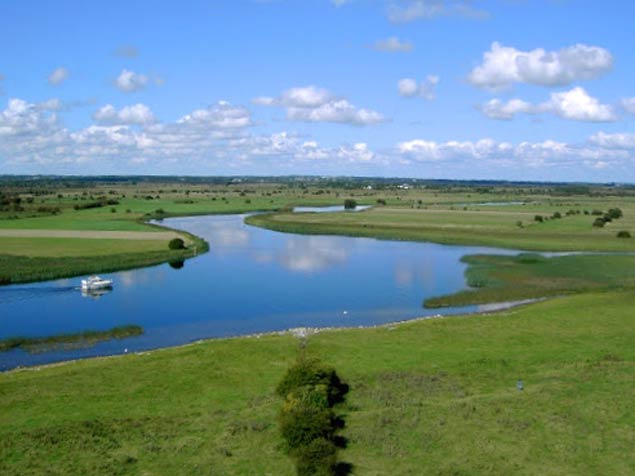 The lordly River Shannon provides much better opportunities for social distancing than the typical English canal.
The lordly River Shannon provides much better opportunities for social distancing than the typical English canal.
For the unfortunate Welsh with their long border with England, yet with a higher proportion of at-risk people in their population, the extension of the Lockdown is insisted. But whether the Welsh can stop the English pouring over the border this weekend is a moot point. Even at the height of the Lockdown, a policeman in Llandudno in North Wales flagged down a be-leathered man on a large shiny motorbike, to be told that he was just out running an urgent errand. The errand was apparently to buy sausages. His point of departure? Nottingham.
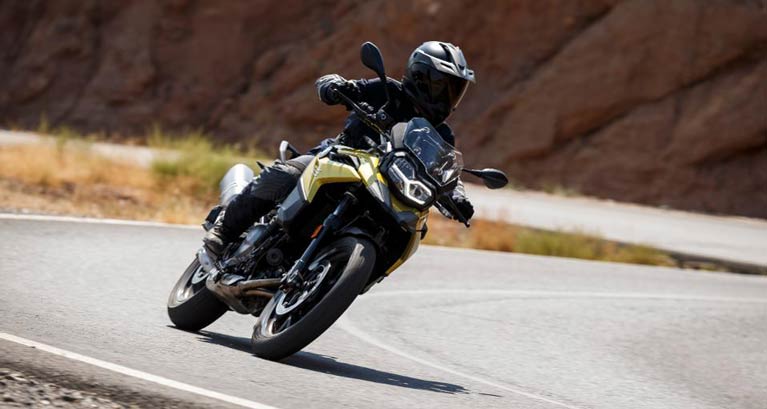 In the Lockdown period in England, this has proved to be the ideal machine for nipping down to the shops for a packet of sausages
In the Lockdown period in England, this has proved to be the ideal machine for nipping down to the shops for a packet of sausages
Inevitably, away to the north, the instinctive hostility between the English and the Scots has been regularly re-surfacing. It’s only a matter of time – if it hasn’t been done already - before someone quotes the quintessential English writer PG Wodehouse’s comment: “It is never difficult to distinguish between a Scotsman with a grievance and a ray of sunshine”.
Meanwhile the rather wishy-washy slogan “Stay Alert” has become national policy. At least they’d the sense to use this version. There are those among us who can remember some other crisis when the official exhortation was “Be Alert”. This didn’t last long, as the local Voluntary Thought Police were soon adding “The World Needs More Lerts” underneath.
Whatever, already we are in the blame game, and on that count, we should remember the wickedly effective re-working of the pious thoughts of the famous American sports-writer Grantland Rice (1880-1954):
“And when the One Great Scorer comes,
To write against your name,
He marks not that you won or lost,
But how you spread the blame”
That will be the theme in London and elsewhere for quite some time, and in contemplating the happenings on that larger island next door, some of us might incline to the scary thought that we are seeing the Romans becoming Italians, with the Dark Ages imminent, and with the occasional complete pessimist perhaps even wishing that St George’s Channel were at least twice as wide.
 Social distancing, Cheltenham style. Even in imminent pandemic times, no patriotic Irish race enthusiast could be anywhere else.
Social distancing, Cheltenham style. Even in imminent pandemic times, no patriotic Irish race enthusiast could be anywhere else.
As it is, in retrospect there are two people across the water that we can blame for some of the Covid-19 in Ireland. One is whoever decided that the Cheltenham National Hunt Festival should go ahead, where the hazards were immediately obvious once it was under way. And the other is Jurgen Klopp. For had not Herr Klopp brought Liverpool Football Club to such a peak of excellence, their many Irish supporters would not have been obliged to mix at a crucial time in pandemic development with vast numbers of infective Spanish and Italian fans at the international championship fixtures that his inspired team management had made possible.
 Jurgen Klopp’s huge success in managing Liverpool FC may have contributed to Ireland’s experience of Covid-19
Jurgen Klopp’s huge success in managing Liverpool FC may have contributed to Ireland’s experience of Covid-19
Even with St George’s Channel at only fifty nautical miles wide, and the North Channel even narrower, there still seems to be a really useful saltwater cordon sanitaire between Ireland and chaos, and while there has been the occasional squabble, the level of social cohesion and adherence to the rules of Lockdown in Ireland have been encouragingly high. But such a balancing act can be maintained for only so long, and people are climbing the walls in their hopes of getting back to some form of sailing, or afloat in some way.
Thus this week here in Howth we’d a keen sea angler who thought he might get away with a couple of hours of his beloved sport if he launched his little outboard boat from an almost-forgotten ramp hidden away outside the back of the harbour. For although sailing is a complete no-no under total lockdown, as even the smallest sailing boat sticks out like a sore thumb, any little powered boat suddenly appearing past the harbour mouth is assumed by casual observers to be a local lobsterman going legitimately about his business, the launching and so forth having been well hidden from the real lobstersmen within the harbour.
 Howth Harbour from the north. A little-known launching ramp to the west of the harbour was utilized by a desperate sea angler to launch his boat in secret, but an engine break-down blew his cover.
Howth Harbour from the north. A little-known launching ramp to the west of the harbour was utilized by a desperate sea angler to launch his boat in secret, but an engine break-down blew his cover.
But God is not mocked, as our Cunning Cod Catcher discovered. His engine wouldn’t re-start when his fun was finished. So the Howth Inshore Lifeboat had to bring him in. But as there are so few clearly established laws and rules about how to act in this current exceptional situation, with no statutory body with any muscle to take responsibility and prosecute in some way, the Flexible Fisherman simply stayed absolutely schtum, didn’t say a single word to anyone, and it all just petered out when everyone had to go home for their tea.
But after Monday (May 18th) we’re told that easing is going to begin, and soon those golfers who have been managing to slip under the radar (for we’ve ten golf courses more or less within five kilometres of here) will now be legitimate provided they’re maintaining Social Distance.
That noted mover and shaker in sailing progress, Peter Ryan the Chairman of the Irish Sea Offshore Racing Association, reckons the Social Distance two metre requirement is the stumbling block, and while Mark Mansfield of Cork has been thinking long and seriously about how to resume keelboat racing while complying with pillars of the current policy, Peter Ryan reckons the authorities are going to have to re-think on this one, particularly if valid testing methods can be securely in place.
 Sociable times. Peter Ryan of ISORA (right) at the launching of a Race Sponsorship with John Rutter and Michael Martyn of Kona. But in the current difficult times, Ryan is looking at ways in which such socialising can be minimized in order to allow offshore racing to take place.
Sociable times. Peter Ryan of ISORA (right) at the launching of a Race Sponsorship with John Rutter and Michael Martyn of Kona. But in the current difficult times, Ryan is looking at ways in which such socialising can be minimized in order to allow offshore racing to take place.
Then too, we can expect mask-wearing to be mandatory. This is a pain for those of us who wear spectacles, as many mask designs cause our glasses to mist up, such that while we may be models of infection protection as we move about the place, it’s not a good look if you’re trying to ride a bike, drive a car or simply walk on a pavement in keeping with current social distance requirements, as you’ll be more concerned with not walking misty-eyed into barely-seen other people or trees or lamp-posts or buses.
So where is our much-vaunted “Sense of Freedom in Sailing” in all this? Well, it’s still there when sailing is in its purest minimalist form, which has to be kite-surfing or windsurfing. This is pop-up sailing, requiring virtually no shoreside infrastructure, and you don’t need a car, let alone a car and trailer, to get your “vehicle” into action. It’s absolutely fine and about as socially-distanced as you can get provided you remain in control of the situation. But if you get into difficulties and require rescuing, you’re immediately into a situation of intimate potential infection, and spoiling the sport for everyone else.
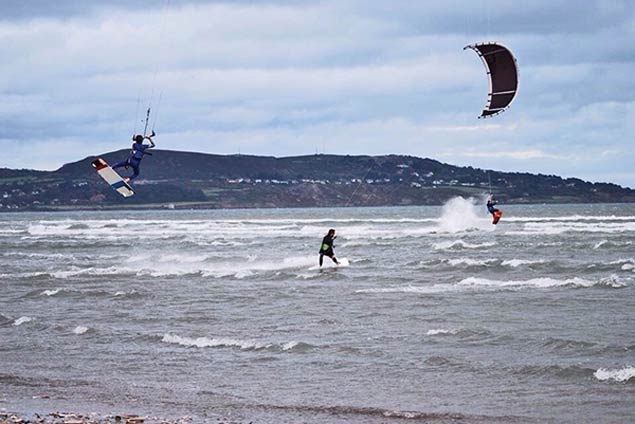 Kitesurfing in Dublin Bay. It may not be sailing as most of us know or expect it, but it’s the form of sailing which is most compliant with Social Distancing and other Covid19 requirements
Kitesurfing in Dublin Bay. It may not be sailing as most of us know or expect it, but it’s the form of sailing which is most compliant with Social Distancing and other Covid19 requirements
Moving on up the size scale, the next least infective sailing sport is surely for someone who has his or her own driving licence and a tow vehicle and a versatile trailer for something solo-sailed like a Laser or the significantly lighter RS Aero, ideally with a beach to launch from, for at all times it’s the avoidance of sociability-encouraging shoreside infrastructure which is the key.
But if we move into any boat size above that, the anti-infection problems rise exponentially, and we’re very quickly into areas where intense shoreside socializing is an integral part of the complete sailing/regatta experience. Yet although the cancellation of the Glandore Classics in mid-July was something we could take in our stride, as it was in a sense linked to the already-cancelled RCYC Tricentenary Cork Week, the cancellation of Cruinniu na mBad in Kinvara, scheduled for the 14th to 16th August, was something of a wake-up call (and a shock) when it came at precisely 11.19 on Wednesday morning.
 Dr Mick Brogan (left) with his Arctic voyaging shipmate Jarlath Cunnane at the Ilen Reception at the Royal Irish YC a year ago. It was with heavy hearts that Dr Brogan and his Committee decided this week that Cruinniu na mBad 2020 in Kinvara in August had to be cancelled. Photo: W M Nixon
Dr Mick Brogan (left) with his Arctic voyaging shipmate Jarlath Cunnane at the Ilen Reception at the Royal Irish YC a year ago. It was with heavy hearts that Dr Brogan and his Committee decided this week that Cruinniu na mBad 2020 in Kinvara in August had to be cancelled. Photo: W M Nixon
For mid-August is all of three months away, and with the current hopeful progress in handling the pandemic, we couldn’t help but hope that Kinvara might be a real possibility. But the Kinvara chairman Dr Mick Brogan is a Connacht GP in addition to his many traditional boat regatta and voyaging credentials, he brought his medical knowledge to his Committee’s acute awareness of just how un-self-consciously and totally sociable the Kinvara gathering is, and they regretfully but decisively pulled down the shutters.
In fact, Kinvara during Crunnui na mBad is sociability on a scale which well matches the apres-ski scene in the Alpine village of Ischgi in the Austrian Tyrol, which was notoriously one of the earliest hotbeds of Covid-19 infection in Europe, and it would be tempting fate and rejecting the science to think that even three months hence, Cruinnui na mBad could safely be staged.
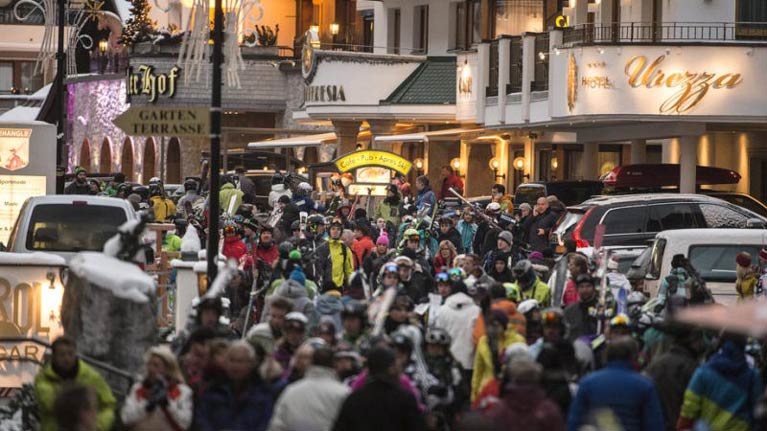 Hotbed of infection – the après ski scene at Ischgi in Austria
Hotbed of infection – the après ski scene at Ischgi in Austria
 Where social distancing is impossible – aboard Mick Brogan’s traditional ketch Mac Duach at Cruinniu na mBad at Kinvara
Where social distancing is impossible – aboard Mick Brogan’s traditional ketch Mac Duach at Cruinniu na mBad at Kinvara
But not all sailing events are so closely inter-woven with a massive social gathering ashore, and while it’s a bit rough on established yacht club hospitality facilities to suggest such a thing, in the extremity of our current situation, with enthusiastic sailors mad keen to get afloat, it should be possible to devise sailing events involving little or no shoreside infrastructure at all.
We discussed some aspects of this four weeks ago in outlining Peter Ryan of ISORA’s thinking about the possible staging of the Dublin Bay to Cork Harbour Race as early as 31st July, and it’s a theme which can usefully be developed if the authorities don’t completely put the kibosh on such ideas.
For the heart of it all is ISORA’s offshore nature. It could be argued that its HQ is a waypoint midway between Dublin Bay and Anglesey. Thus all its activities can be totally offshored and certified disease-free. Its members’ boats would only be eligible to race if they can produce an electronically-verified medical certificate showing that all their crews are virus-free as they assemble aboard to race. Thus they will in effect become a healthy family bubble going sailing.
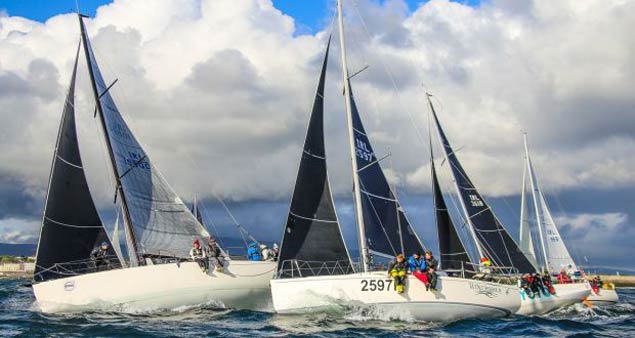 The ISORA fleet getting away for an offshore race which started outside Dun Laoghaire Harbour. Provided each crewmember is certified free of Covid-19, ISORA could provide racing without any direct reliance on shoreside infrastructure or facilities. Photo Afloat.ie/David O’Brien
The ISORA fleet getting away for an offshore race which started outside Dun Laoghaire Harbour. Provided each crewmember is certified free of Covid-19, ISORA could provide racing without any direct reliance on shoreside infrastructure or facilities. Photo Afloat.ie/David O’Brien
As for all the administration of the racing, it can be done with a fast and seaworthy committee boat (something like John Brennan’s new Redbay Stormforce 1650 as recently revealed on Afloat.ie would be ideal) complete with virus-free crew. The speed and seaworthiness are important as both the start point and the finish as monitored by this one boat have to be kept as flexible concepts, and while the use of a shore point for the other end of the start and finish lines is preferable to give the people on land some sense of identifying with the race, it’s not essential, and the South Burford Buoy in Dublin Bay and the Daunt Buoy off Cork Harbour could serve equally well.
It’s appreciated that with such a setup, the temptation to simply keep the fleet in the Irish Sea and make up the miles with a course taking in the Isle of Man or other in-place fixed marks would be considerable. But we have to remember we’re talking 24-carat gold sailing history here with the 160th anniversary commemoration of the totally-pioneering Dublin Bay to Cork Harbour Race of 1860, so a bit of respect for some tradition is very much in order.
Meanwhile, there’s nothing more exasperating than people insisting that they have to have a clearcut and transparent plan with definite figures and real dates so that they can “confirm the arrangements of their own personal programme”.
You would think that we’re facing into a busy summer with a hectic choice of May Balls, June Regattas, and July Gala Events. But the fact is, folks, we’re facing into a desert. Thus ingenious sailing ways of getting around this are now top of the agenda, but they’re not going to happen any time soon. And with scant rainfall since February, it may become a desert in more ways then we’d like.
 With some really imaginative thinking and compliance with restrictions, we may be able to ensure that this is not the memory we carry forward from the Irish sailing season of 2020.
With some really imaginative thinking and compliance with restrictions, we may be able to ensure that this is not the memory we carry forward from the Irish sailing season of 2020.
While many glassfibre boats may have been kept happily afloat through the winter in their marina berths, most wooden traditional and classic craft have been lifted ashore. Even where they are stored under good covers, the recent prolonged periods of bright sunlight, extreme afternoon heat, and exceptional night-time cold have been very bad indeed for their old timbers. Ideally, they should be afloat as soon as possible. But if that isn’t permitted until some time in June, then relief can be provided with regular gentle hosing.
Yet already we’re being warned of imminent water shortages, and it’s only mid-May. The use of hosepipes might soon be severely curtailed. Could it be that - to add to all our woes - we’re going to finally have to accept that, for many years, we have been managing our island’s unrivalled availability of perfect freshwater with the same expertise that the Venezuelans have been showing in the handling of their abundant oil reserves?
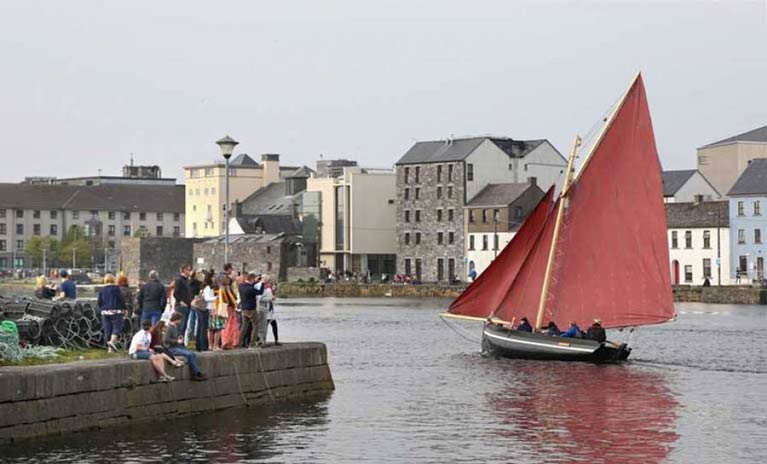 The restored Gleoiteog type Galway Hooker Lovely Anne sailing into the River Corrib off The Claddagh in Galway. The timbers of traditionally-built wooden boats like this are particularly prone to deterioration when ashore in hot weather and intense sunshine. They need to be regularly dampened at the very least, and ideally, they should be afloat
The restored Gleoiteog type Galway Hooker Lovely Anne sailing into the River Corrib off The Claddagh in Galway. The timbers of traditionally-built wooden boats like this are particularly prone to deterioration when ashore in hot weather and intense sunshine. They need to be regularly dampened at the very least, and ideally, they should be afloat
Coronavirus Forces Postponement of Two Key Marine Events
Uncertainty over the spread of the coronavirus Covid-19 has influenced postponement of the annual Irish Skipper Expo and a charity evening in aid of the Lost at Sea Tragedies (LAST) next weekend, writes Lorna Siggins.
Mara Media, which organises the Irish Skipper Expo, said the show originally scheduled for Limerick on March 13th and 14th will be held at a later date.
“We regretfully announce that we are postponing next week’s Irish Skipper Expo 2020, but our foremost concern is the health and safety of exhibitors and visitors to the event, Mara Media managing director Hugh Bonner said in a statement.
“The advice we have received from Health Service Executive Ireland (HSE) is that while coronavirus in Ireland is still in the containment phase, it is a rapidly evolving situation, and as such, rescheduling the show is the only sensible and pragmatic option,” he said.
Earlier today, Taoiseach Leo Varadkar had said that there was no recommendation to cancel mass gatherings at this stage.
Mr Bonner said that this was “not a decision we have taken lightly, and we appreciate the difficulties this will cause because of the planning involved in attending the expo”.
“The wellbeing of exhibitors and visitors is of paramount importance to us,” Mr Bonner said.
“We will be working with our show contractors, and with the wider fishing industry, to put in place a new date which will be announced as soon as possible,” he said, paying tribute to exhibitors for their support at this “challenging time”
The “Fishermen’s Fling” charity gala evening in aid of LAST, also due to be held in Limerick to coincide with the expo on March 13th, has also been postponed until further notice.
Its organiser Niall Duffy said that tickets would remain valid until a new date is announced.




























